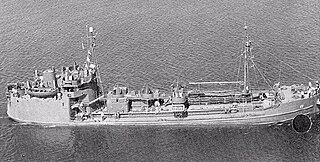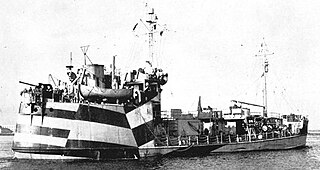
USS Cuyama (AO-3) was a tanker of the United States Navy launched 17 June 1916 by Mare Island Navy Yard; sponsored by Miss M. Offley; and commissioned 2 April 1917.

USS Camel (IX-133), an Armadillo-class tanker, was the second ship of the United States Navy to be named for the camel, a ruminant found in Asia and Africa. She was launched 31 October 1943 as William H. Carruth by California Shipbuilding Corporation, in Wilmington, California, under a Maritime Commission contract sponsored by Mrs. J. Low, was acquired by the Navy 22 November 1943, and commissioned the same day.
The second USS Whippet (IX-129), an Armadillo-class tanker designated an unclassified miscellaneous vessel, was the second ship of the United States Navy to be named for the whippet. Her keel was laid down on 31 October 1943 at New Orleans, Louisiana, by the Delta Shipbuilding Company under a Maritime Commission contract. She was launched on 15 December 1943 sponsored by Mrs. Will Camp Sealy, delivered to the Navy on 13 January 1944, and commissioned on 14 January 1944.

USS Kankakee (AO-39) was a Kennebec-class fleet oiler of the United States Navy. The ship was built as SS Colina by Bethlehem Steel Co., Sparrows Point, Maryland, launched on 24 January 1942, sponsored by Mrs. D. A. Little, acquired for the Navy on 31 March through the Maritime Commission from her owner, Socony-Vacuum Oil Company, New York City, and commissioned as Kankakee at Norfolk, Virginia, on 4 May.
USS Yahara (AOG-37) was a Mettawee-class gasoline tanker acquired by the U.S. Navy for the dangerous task of transporting gasoline to warships in the fleet, and to remote Navy stations.

USS Neshanic (AO-71) is a former T3 Kennebec-class oiler constructed for the United States Navy during World War II. She was the only U.S. Navy ship named for the Neshanic River in New Jersey.

USS Agawam (AOG-6) was a Patapsco-class gasoline tanker acquired by the U.S. Navy for the dangerous task of transporting gasoline to warships in the fleet, and to remote Navy stations.

USS Mettawee (AOG-17) was a Mettawee-class T1 tanker type gasoline tanker acquired by the U.S. Navy for the dangerous task of transporting gasoline to warships in the fleet, and to remote Navy stations.
USS Seekonk (AOG-20) was a Mettawee-class gasoline tanker acquired by the U.S. Navy for the dangerous task of transporting gasoline to warships in the fleet, and to remote Navy stations.
USS Sequatchie (AOG-21) was a Mettawee-class gasoline tanker acquired by the U.S. Navy for the dangerous task of transporting gasoline to warships in the fleet, and to remote Navy stations.
USS Ammonusuc (AOG-23) was a Mettawee-class gasoline tanker acquired by the U.S. Navy for the dangerous task of transporting gasoline to warships in the fleet, and to remote Navy stations.
USS Ochlockonee (AOG-33) was a Mettawee-class gasoline tanker acquired by the U.S. Navy for the dangerous task of transporting gasoline to warships in the fleet, and to remote Navy stations.

USS Ontonagon (AOG-36) was a Mettawee-class gasoline tanker acquired by the U.S. Navy for the dangerous task of transporting gasoline to warships in the fleet, and to remote Navy stations.

USS Ponchatoula (AOG-38) was a Mettawee-class gasoline tanker acquired by the U.S. Navy for the dangerous task of transporting gasoline to warships in the fleet, and to remote Navy stations.
USS Sacandaga (AOG-40) was a Mettawee-class gasoline tanker acquired by the U.S. Navy for the dangerous task of transporting gasoline to warships in the fleet, and to remote Navy stations.
USS Towaliga (AOG-42) was a Mettawee-class gasoline tanker acquired by the U.S. Navy for the dangerous task of transporting gasoline to warships in the fleet, and to remote Navy stations.
USS Tularosa (AOG-43) was a Mettawee-class gasoline tanker acquired by the U.S. Navy for the dangerous task of transporting gasoline to warships in the fleet, and to remote Navy stations.
USS Wakulla (AOG-44) was a Mettawee-class gasoline tanker acquired by the U.S. Navy for the dangerous task of transporting gasoline to warships in the fleet, and to remote Navy stations.
USS Waupaca (AOG-46) was a Mettawee-class gasoline tanker acquired by the United States Navy for the dangerous task of transporting gasoline to warships in the fleet, and to remote Navy stations.

USS Natrona (APA-214) was a Haskell-class attack transport of the US Navy in World War II. She was of the VC2-S-AP5 Victory ship design type. Natrona was named for Natrona County, Wyoming.








